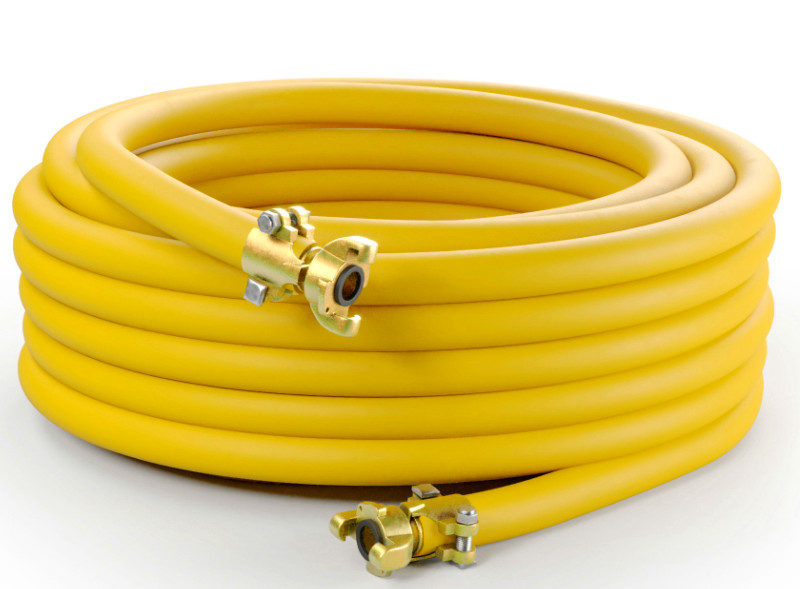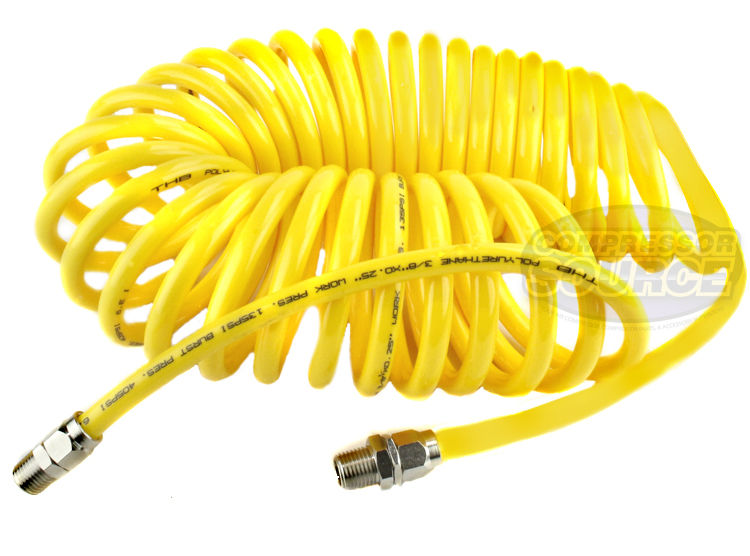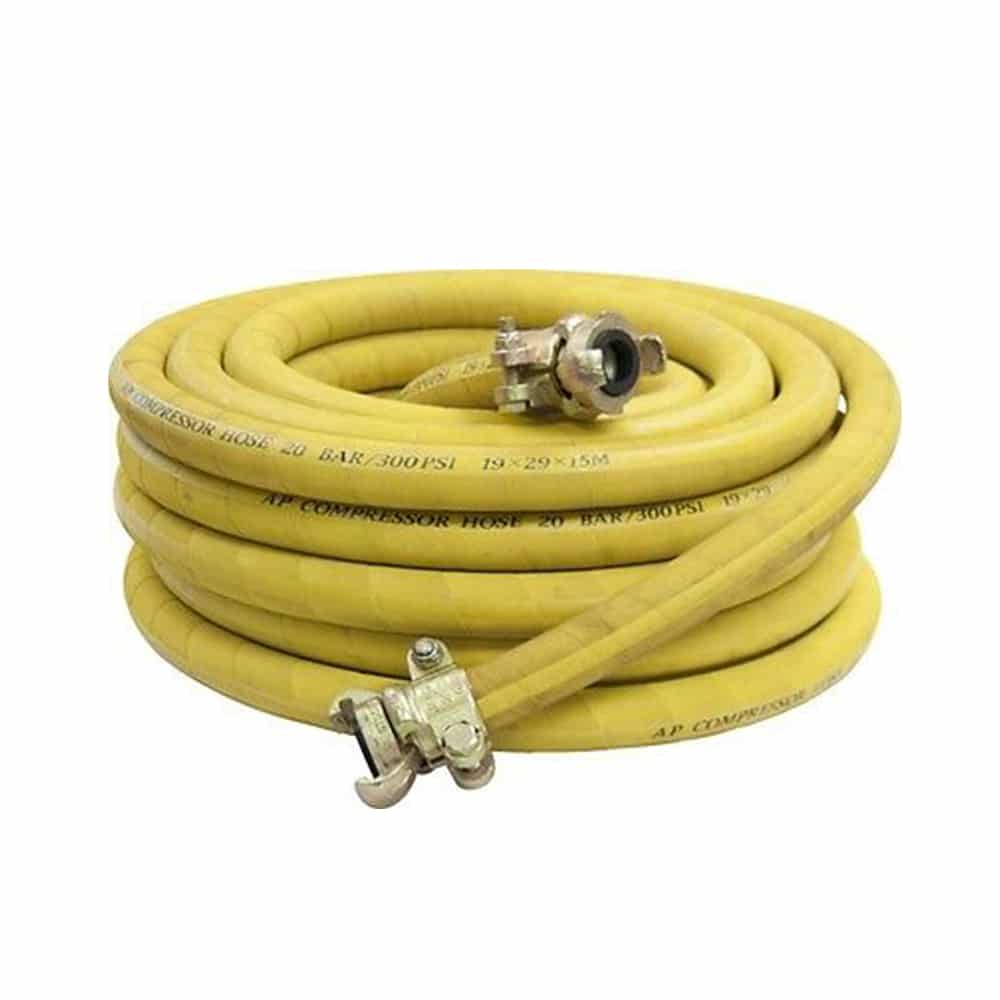When you rely on an air compressor, having the right air hose makes all the difference. Your air hose is the link that delivers power from your compressor to your tools.
If it’s not up to the task, you could face leaks, poor performance, or even damage to your equipment. You’ll discover how to choose the perfect air hose that fits your needs, keeps your work running smoothly, and saves you time and money.
Ready to make your air compressor work smarter? Let’s dive in.
Types Of Air Hoses
Air hoses connect air compressors to tools and machines. Choosing the right type affects performance and safety. Different materials suit various tasks and environments. Understanding each type helps pick the best hose for your needs.
Rubber Air Hoses
Rubber air hoses are strong and flexible. They resist abrasion and harsh weather well. These hoses handle high pressure and stay durable. They work well in tough job sites and cold conditions. Rubber hoses are heavier but last long.
Pvc Air Hoses
PVC air hoses are lightweight and affordable. They resist chemicals and sunlight damage. These hoses are less flexible than rubber but easier to carry. PVC hoses suit light to medium tasks. They do not perform well in very cold weather.
Hybrid Air Hoses
Hybrid air hoses combine rubber and PVC features. They offer flexibility and durability at once. These hoses are lighter than rubber but tougher than PVC. Hybrids resist kinks and wear well. They work in many different conditions.
Polyurethane Air Hoses
Polyurethane air hoses are very light and flexible. They resist cuts and abrasions better than others. These hoses stay soft in cold weather. Polyurethane hoses are ideal for delicate tools and tight spaces. They last long but cost more.
Key Features To Consider
Choosing the right air hose for your air compressor is important. It affects how well your tools work and how safe you stay. Knowing the key features helps you pick the best hose for your needs.
Length And Diameter
Pick a hose length that fits your workspace. Too short limits movement. Too long can reduce air pressure. Diameter matters too. Bigger diameter means more air flow. Choose one that matches your tool’s needs.
Pressure Ratings
Check the hose’s pressure rating. It must handle the air compressor’s output. Using a hose with low rating can cause bursts. Always choose a hose with a higher pressure rating than your compressor.
Flexibility And Weight
Flexible hoses are easier to move and store. Heavy hoses can tire you out quickly. Look for a hose that bends easily but stays strong. Lightweight hoses improve comfort during long jobs.
Temperature Resistance
The hose should withstand the temperature of the air and environment. Some hoses work well in cold or hot places. Choose one that resists cracking or softening due to heat or cold.
Choosing The Right Hose Material
Choosing the right hose material for your air compressor is important. The right material ensures safety, efficiency, and long life. It also helps avoid leaks and damage during use. Different materials suit different tasks and environments. Understanding key factors helps pick the best hose for your needs.
Durability Factors
Durability depends on the hose material’s strength and flexibility. Some materials resist wear and tear better than others. Look for hoses that handle pressure well. Strong materials last longer and reduce replacement costs. Flexibility prevents cracks and breaks during bending or twisting.
Chemical Resistance
Certain tasks expose hoses to oils, fuels, or solvents. Choose a material that resists these chemicals to avoid damage. Some hoses work well with petroleum-based products. Others suit water or air only. Chemical resistance protects the hose and keeps your system clean.
Environmental Conditions
Consider the environment where you use the hose. Extreme heat or cold can weaken some materials. Outdoor use may require UV-resistant hoses. Wet or humid places need materials that resist mold and mildew. Picking the right hose material prevents early failure.
Hose Couplings And Fittings
Hose couplings and fittings are key parts of any air compressor setup. They connect the hose to tools, machines, or other hoses. Good fittings keep the air flowing smoothly and safely. Choosing the right coupling ensures strong, secure connections.
Couplings and fittings come in many shapes and sizes. Each type fits different needs and tools. Understanding these types helps pick the best one for your job.
Common Types Of Fittings
Quick-connect fittings allow fast and easy hose changes. They snap together without tools. Threaded fittings screw on tightly for a secure hold. Barbed fittings grip the hose inside for a firm seal. Each type works well for specific uses and pressure levels.
Connection Methods
Threaded connections twist hoses and fittings together. They need tight screwing to avoid air leaks. Quick-connect systems click parts into place fast. Some use clamps to hold hoses on barbed fittings. Proper connection keeps the air pressure steady and safe.
Ensuring Leak-free Joints
Leaks waste air and lower tool power. Use thread seal tape on threaded fittings to block leaks. Check that all connections fit snugly and tightly. Replace worn or damaged parts to keep joints air-tight. Regular inspection avoids costly problems and helps tools work well.
Maintenance Tips For Longevity
Air hoses for air compressors need care to last long. Proper maintenance keeps hoses safe and working well. Follow simple steps to avoid damage and costly replacements. Regular care improves safety and saves money.
Proper Storage Techniques
Store air hoses in a cool, dry place away from sunlight. Avoid sharp bends or kinks when coiling hoses. Use hose reels or hangers to keep them off the ground. Keep hoses away from chemicals and heat sources. Proper storage stops cracks and wear.
Regular Inspection Practices
Check hoses often for cracks, leaks, or weak spots. Look for signs of wear near fittings and bends. Test hoses by running air and listening for leaks. Replace damaged hoses immediately to prevent accidents. Frequent inspections catch problems early.
Cleaning And Repairs
Clean hoses with mild soap and water after use. Remove dirt and debris from inside and outside. Dry hoses completely before storing to prevent mold. Fix small leaks with tape or patches designed for air hoses. For big damage, replace the hose for safety.

Credit: www.somaxflex.com
Safety Precautions
Safety is the top priority when using air hoses for air compressors. Ignoring safety rules can cause accidents and injuries. Understanding how to handle hoses properly helps protect you and your tools. Follow safety steps to avoid damage and stay safe during work.
Avoiding Hose Damage
Keep hoses away from sharp edges and hot surfaces. Do not bend hoses too tightly or pull them hard. Store hoses in a cool, dry place to prevent cracking. Check hoses regularly for cracks or leaks. Replace damaged hoses immediately to avoid accidents.
Handling High-pressure Situations
Use hoses rated for the pressure of your air compressor. Do not exceed the maximum pressure limit of the hose. Slowly open valves to control pressure and avoid sudden bursts. Release pressure before disconnecting hoses to prevent injury. Never use damaged hoses under high pressure.
Protective Gear Recommendations
Wear safety goggles to protect your eyes from debris. Use gloves to avoid cuts and burns from hot hoses. Wear ear protection if the compressor noise is loud. Choose non-slip shoes to prevent falls in the work area. Always wear proper gear to stay safe during tasks.
Optimizing Air Compressor Performance
Optimizing air compressor performance depends greatly on the quality and setup of air hoses. The right hose can save energy and improve tool efficiency. Poor hose choices or layouts waste air and reduce power. Small changes in hose management create big results for any workshop or job site.
Reducing Air Loss
Air loss happens when hoses leak or wear out. Check hoses regularly for cracks or holes. Use durable materials that resist damage and keep air sealed inside. Tight connections stop air from escaping at joints and fittings. Less air loss means the compressor uses less energy to keep pressure steady.
Minimizing Pressure Drops
Pressure drops occur when air travels through long or narrow hoses. Choose hoses with the right diameter to match your compressor’s needs. Avoid sharp bends and kinks that block airflow. Smooth interior hoses allow air to flow freely. Keeping pressure steady helps tools work at full strength.
Efficient Hose Layout
Plan hose routes to avoid unnecessary length and obstacles. Use reels or hangers to keep hoses off the floor and prevent damage. Group hoses by task to reduce confusion and make changes easier. A neat layout saves time and keeps air flowing at optimal pressure.

Credit: compressor-source.com
Common Issues And Troubleshooting
Air hoses for air compressors often face common problems that affect performance. Knowing how to spot and fix these issues keeps your tools running smoothly. Quick checks and simple fixes save time and money.
Leaks And Burst Hoses
Leaks reduce air pressure and slow down work. Look for cracks or holes on the hose surface. Use soapy water to find small leaks; bubbles will appear. Replace hoses that burst or show large damage. Tighten fittings to stop leaks at connections.
Kinks And Twists
Kinks block air flow and strain the hose. Avoid sharp bends during use and storage. Straighten twisted hoses carefully to restore air flow. Coil hoses loosely to prevent future kinks. Use hose reels or guides for easy handling.
Pressure Fluctuations
Pressure drops can reduce tool power. Check hose length and diameter; too long or narrow hoses cause loss. Inspect for leaks that lower pressure. Clean or replace clogged air filters. Maintain compressor settings for steady pressure.
Top Brands And Products
Choosing the right air hose for your compressor is important. The best brands offer quality, durability, and safety. This section highlights top brands and products that meet different needs and budgets. It helps you find the perfect hose for any task.
High-quality Hose Manufacturers
Brands like Flexzilla, Goodyear, and DeWalt make top-quality air hoses. They use strong materials that resist wear and tear. Their hoses handle high pressure without leaking. These brands ensure long-lasting performance for professional use.
Budget-friendly Options
For simple tasks, brands like Campbell Hausfeld and Craftsman offer affordable hoses. These hoses provide good quality at a lower price. They suit DIY projects and occasional use. Budget hoses still offer safety and decent durability.
Specialty Hoses For Specific Tasks
Some jobs need special hoses. For example, oil-resistant hoses for mechanical work or lightweight hoses for easy handling. Brands like Milton and PCL offer hoses designed for these tasks. Specialty hoses improve efficiency and safety in unique conditions.

Credit: www.blastsparesdirect.com
Frequently Asked Questions
What Materials Are Best For Air Compressor Hoses?
Air compressor hoses are commonly made from rubber, PVC, or polyurethane. Rubber hoses offer flexibility and durability. PVC hoses are lightweight and cost-effective. Polyurethane hoses resist kinks and abrasions. Choose based on your specific needs and working conditions for best performance.
How To Choose The Right Air Hose Length?
Select an air hose length that fits your workspace comfortably. Too short limits movement; too long can cause pressure drops. Measure the distance from your compressor to the tool. Add extra length for flexibility and avoid overstretching the hose during use.
Can Air Hoses Handle High Pressure Safely?
Yes, quality air hoses are designed for specific pressure ratings. Always check the hose’s maximum PSI rating before use. Using hoses beyond their pressure limits risks bursting and accidents. Choose hoses rated higher than your compressor’s output pressure for safety.
How To Prevent Air Hose Kinking And Damage?
Avoid sharp bends and excessive twisting to prevent kinks. Store hoses properly by coiling them loosely. Use hoses made from kink-resistant materials like polyurethane. Regularly inspect hoses for wear and replace damaged sections promptly.
Conclusion
Choosing the right air hose keeps your air compressor working well. Strong, flexible hoses last longer and prevent leaks. Check the hose size and material for your tasks. Safety matters—inspect hoses often for damage or wear. Good maintenance saves money and time.
A quality air hose makes your work easier and safer. Keep these tips in mind for better results. Your tools deserve the best parts to perform well. Simple steps lead to smooth, worry-free operation every day.

